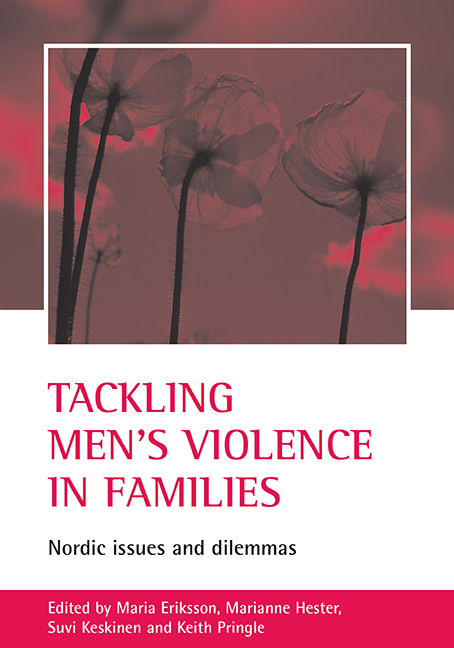Book contents
- Frontmatter
- Contents
- List of tables and figures
- Acknowledgements
- Notes on contributors
- one Introduction: Nordic issues and dilemmas
- two Children, abuse and parental contact in Denmark
- three Commitments and contradictions: linking violence, parenthood and professionalism
- four “Talking feels like you wouldn’t love Dad anymore”: children’s emotions, close relations and domestic violence
- five Bypassing the relationship between fatherhood and violence in Finnish policy and research
- six Marching on the spot? Dealing with violence against women in Norway
- seven Children’s peace? The possibility of protecting children by means of criminal law and family law
- eight A visible or invisible child? Professionals’ approaches to children whose father is violent towards their mother
- nine “Take my father away from home”: children growing up in the proximity of violence
- ten Neglected issues in Swedish child protection policy and practice: age, ethnicity and gender
- eleven Tackling men’s violence in families: lessons for the UK
- References
- Index
eight - A visible or invisible child? Professionals’ approaches to children whose father is violent towards their mother
Published online by Cambridge University Press: 20 January 2022
- Frontmatter
- Contents
- List of tables and figures
- Acknowledgements
- Notes on contributors
- one Introduction: Nordic issues and dilemmas
- two Children, abuse and parental contact in Denmark
- three Commitments and contradictions: linking violence, parenthood and professionalism
- four “Talking feels like you wouldn’t love Dad anymore”: children’s emotions, close relations and domestic violence
- five Bypassing the relationship between fatherhood and violence in Finnish policy and research
- six Marching on the spot? Dealing with violence against women in Norway
- seven Children’s peace? The possibility of protecting children by means of criminal law and family law
- eight A visible or invisible child? Professionals’ approaches to children whose father is violent towards their mother
- nine “Take my father away from home”: children growing up in the proximity of violence
- ten Neglected issues in Swedish child protection policy and practice: age, ethnicity and gender
- eleven Tackling men’s violence in families: lessons for the UK
- References
- Index
Summary
This chapter points out some of the contradictions and dilemmas associated with current Swedish attempts to create gender equality – including shared parenting and a ‘new father’ – and attempts to promote children's interests. In legal cases concerning custody, contact or residence in Sweden, a particular group of social workers, the socalled family law secretaries (word-for-word translation), conduct the investigations that form part of the basis for the court's decision. Furthermore, the family law secretaries also lead cooperation talks – that is, mediation – with separated parents who want to settle conflicts involving children. The practices of this group of professionals are crucial for children's safety and wellbeing post-separation/divorce when the father has been violent towards the mother and/or the child. In what follows, the work of these professionals in cases where there is a history of violence by the father towards the mother is discussed. Furthermore, the chapter explores how family law secretaries perceive the child's situation and needs when the child's father has been violent. The aim is to shed light on the position of abused children in court mandated investigations concerning custody, residence or contact.
The chapter is based on research into Swedish family law and policy, and how fathers’ violence is dealt with (Eriksson, 2003). The research consisted of three interlinked studies of what constructions of age, gender and kinship mean for the handling of fathers’ violence against mothers/co-parents and children. The first study built upon public documents from three policy areas (‘violence in close relationships’; ‘parenthood, separation and divorce’; and ‘children at risk’), and investigated how the issue of violence from fathers is handled in social policy. The second study built on thematically structured interviews with abused separated mothers and investigated what the father's or coparent's violence means for the everyday life of mothers post-separation, and how the violence is handled by the mothers. The third study built on thematically structured interviews with family law secretaries and investigated how these professionals handle violence by fathers. This chapter draws primarily on the interviews with family law secretaries.
Violent fathers in Swedish social policy
Since the Second World War, there has in Sweden (as in most Western countries) been an increase in divorce, and later separation by cohabiting parents.
- Type
- Chapter
- Information
- Tackling Men's Violence in FamiliesNordic Issues and Dilemmas, pp. 119 - 136Publisher: Bristol University PressPrint publication year: 2005



